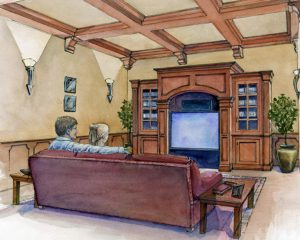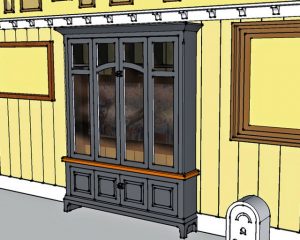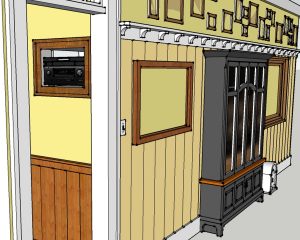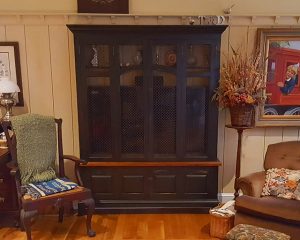 If you do not want your flat screen TV displayed proudly on the wall in the family room, one good solution is to house the HDTV in a fine cabinet that enhances your room décor. However, today’s flat-screen HDTV’s and home theaters present unique challenges for design of wooden element and, especially, cabinetry. Thin contemporary flat screen TVs do not require the deep cabinets that once housed bulky TV’s of the past. In fact, new TVs now look very much out of place hidden in a re-purposed armoire or deep cabinet.
If you do not want your flat screen TV displayed proudly on the wall in the family room, one good solution is to house the HDTV in a fine cabinet that enhances your room décor. However, today’s flat-screen HDTV’s and home theaters present unique challenges for design of wooden element and, especially, cabinetry. Thin contemporary flat screen TVs do not require the deep cabinets that once housed bulky TV’s of the past. In fact, new TVs now look very much out of place hidden in a re-purposed armoire or deep cabinet.
While TVs have become much thinner, they have simultaneously grown much wider. The modern TV cabinet must be as much as 50% wider than with older CRT TVs. Sadly, high-quality surround-sound components, such as receivers, gaming controllers and DVD players, have not shrunk in depth as rapidly. They often require a 16” to 22” internal cabinet depth. Hence, few more of the unique design dilemmas.
 To make matters more difficult, ergonomic viewing height for TVs have not changed. Even though thin flat screens lend themselves to mounting them on a wall at any height, the best height for viewing remains eye-level – actually, the HDTV should be aligned to place the eyes at slightly above the TV center from the viewing location. Higher arrangement makes for uncomfortable viewing, especially, when seated. Thus, the often used over-the-mantle or aligned with wall art position, is not appropriate – this high placement is certainly not ergonomically suited for comfortable viewing. The exception is in rooms where folks would generally be standing, such as a game room with a pool table.
To make matters more difficult, ergonomic viewing height for TVs have not changed. Even though thin flat screens lend themselves to mounting them on a wall at any height, the best height for viewing remains eye-level – actually, the HDTV should be aligned to place the eyes at slightly above the TV center from the viewing location. Higher arrangement makes for uncomfortable viewing, especially, when seated. Thus, the often used over-the-mantle or aligned with wall art position, is not appropriate – this high placement is certainly not ergonomically suited for comfortable viewing. The exception is in rooms where folks would generally be standing, such as a game room with a pool table.
 With respect the surround-sound system components, the good news is that infrared remote control methods are becoming a thing of the past. Most modern audiophile receivers and other components can now be controlled over open WIFI protocols via iOS or Android based tablet or smart phone apps, or with proprietary specialized technology, rather than infrared (IR) remote controllers. Therefore, the surround sound, DVD and gaming components no longer need to be in the same room, much less, in line of sight, as with previous IR controlled devices. Aside from eliminating a pile of remotes, this allows for the HDTV cabinet to be completely redesigned for a much shallower cabinet depth.
With respect the surround-sound system components, the good news is that infrared remote control methods are becoming a thing of the past. Most modern audiophile receivers and other components can now be controlled over open WIFI protocols via iOS or Android based tablet or smart phone apps, or with proprietary specialized technology, rather than infrared (IR) remote controllers. Therefore, the surround sound, DVD and gaming components no longer need to be in the same room, much less, in line of sight, as with previous IR controlled devices. Aside from eliminating a pile of remotes, this allows for the HDTV cabinet to be completely redesigned for a much shallower cabinet depth.
Additionally, this enables cabinets to be properly proportioned, not just horizontally for the thinner and wider HDTV, but vertically as well. A properly designed HDTV cabinet will enable to the HDTV panel to be placed at a proper viewing height while incorporating design elements that make the TV and the cabinet to look balanced in the room with other furniture. Thoughtful design enables the HDTV cabinet to become a functional and decorative room feature – a piece of furniture – rather than a distraction.
For example, in the HDTV cabinet shown in this photo, the TV pan el is mounted at the proper-seated viewing height. The cabinet lower compartment and upper shelf balance the HDTV aesthetically within the cabinet. The cabinet itself, fit nicely within the space, working in concert with the height of the wall paneling, adjacent furniture and wall art.
el is mounted at the proper-seated viewing height. The cabinet lower compartment and upper shelf balance the HDTV aesthetically within the cabinet. The cabinet itself, fit nicely within the space, working in concert with the height of the wall paneling, adjacent furniture and wall art.
Another consideration reflected in this HDTV cabinet design, is the woven oil-rubbed bronze open grill. In this plan the cabinet doors can remain closed when using the surround sound for music only. Even the horizontal rails (stiles) of the cabinet door decoratively arch over the center channel speaker for clean, unobstructed music with the doors closed – form meets function in this cabinet for today’s HDTV and surround sound systems. At WOOD & Co. we work with our clients to create custom solutions.
